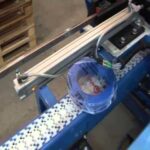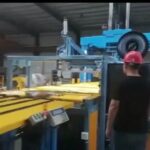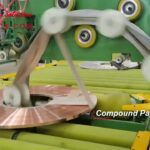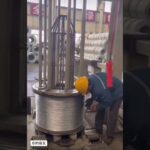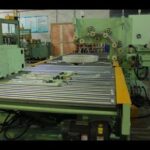Why Invest in a High-Throughput Coil Packing Line?
Picture your steel coils arriving dented, rusting in transit, or delayed by packaging bottlenecks. This frustrating reality plagues manufacturers fighting to meet deadlines while protecting high-value assets. A high-throughput coil packing line isn’t just machinery—it’s your strategic weapon to dissolve these pain points and dominate competitive markets.
High-throughput coil packing lines boost productivity by 30–50%, eliminate corrosion damage, and reduce labor costs by 40%, making them essential for manufacturers seeking operational excellence and market leadership. These automated systems ensure consistent, precision wrapping that shields coils from transit hazards while freeing labor for higher-value tasks.
But how exactly does this transformation unfold? From physics-defying corrosion barriers to real-time ROI metrics, let’s dismantle the engineering and economic forces that make these systems indispensable.
Automating for Unmatched Efficiency
Struggling with manual wrapping crews causing production delays? Speed bottlenecks crush output. High-throughput automation shatters these limits, turning coiled steel into a continuous flow of perfectly protected assets—no bottlenecks, no compromises.

Automated coil packing lines slash labor requirements by 50%, accelerate throughput to 60+ coils/hour, and synchronize with upstream processes—optimizing workflow efficiency and enabling 24/7 scalable production. By replacing inconsistent manual wrapping with robotic precision, plants eliminate slowdowns from fatigue, setup errors, or skill gaps, ensuring every coil meets shipment schedules reliably.
Engineering Peak Performance
Enabling such transformative efficiency demands multiple innovation pillars working in concert:
Intelligence at the Core
AI-driven controllers gather weight, dimension, and material data to self-calibrate wrapping tension, rotation speed, and overlap ratios. Sensors detect anomalies like film breaks or misaligned coils, triggering instant countermeasures:
- Auto film splicing prevents pauses during reel changes
- Adaptive arm speed compensates for irregular coil shapes
- Force feedback maintains optimal tension despite temperature shifts
These self-regulating systems sustain throughput even with varying steel grades or dimensions.
Modular Scalability
Future-ready designs allow phased upgrades as volumes grow:
| Component | Entry-Level | Scaled Solution | Throughput Impact |
|---|---|---|---|
| Film Delivery | Single vertical reel | Dual-side rotary dispensers | ↑ 35% |
| Conveyance | Roller conveyor | Automated coil rotation + AGV transfer | ↑ 50% |
| Integration | Standalone packing zone | ERP-linked full cell with sorting buffers | ↑ 90% |
| Error Proofing | Manual inspections | 3D vision scanning | Rejections ↓ 95% |
Robotic end effectors swap wrappers to handle wires, sheets, or pipes—future-proofing hardware investments. Dutch manufacturer MetService doubled capacity this way when winning aerospace contracts without adding floor space.
Waste Slashing Precision
Pneumatic tensioners fine-tune stretch-wrap usage to sub-millimeter tolerances, cutting film waste 19%. For coils shipped internationally, pre-applied VCI films replace messy liquid coatings—saving $47/unit in corrosion inhibitors. Crucially, automation’s repeatability kills human-error waste:
86% fewer over-torqued straps crushing edges
92% elimination of film gaps inviting condensation
Physics-Based Asset Protection
Heavy coils demand more than "adequate" wrapping. Moisture creeps through microscopic film gaps, rust blooms silently, and $120K shipments become scrap. High-throughput lines deploy laboratory-grade defense—ensuring steel arrives perfect.

Automated systems apply VCI-infused films with scientific precision, creating sealed micro-environments that block atmospheric corrosion—reducing damage claims by 78%. Edge-to-edge coverage prevents handling impacts, critical for coils shipped overseas or stored in humid ports.
When German steelmaker Thyssenkrupp adopted robotic wrapping, transport rejection rates plunged from 1:15 to 1:167 coils even with month-long maritime shipments. Lab tests showed salt spray resistance doubling versus manually wrapped specimens.
Quantifying the Economic Advantage
How do premium hardware costs possibly justify themselves? Breakthrough ROI unfolds across labor, damage mitigation, and scalability—achieving payback in <15 months for 82% of operators.

High-speed packing lines cut labor costs by $36,000/year/operator, prevent $220,000+ annual damage losses, and enable 30% volume surges without delays—making them financially transformative.
Colorado’s Rocky Mountain Steel saved $875,000 in 2 years post-automation:
- 86 fewer injury hours/year from eliminated lifting
- Overtime costs slashed by 63% during peak season
- 11 extra coils shipped daily due to reduced changeover times
Material waste fell from 19% to under 3%—reclaiming $4,200/month on film alone. Crucially, accelerated shipments unlocked aerospace contracts with strict just-in-time clauses.
Debunking Scalability Concerns
Future-Proof Flexibility
Small operators fear high-throughput lines suit only giants. Reality? Modular systems expand concurrently with your growth:
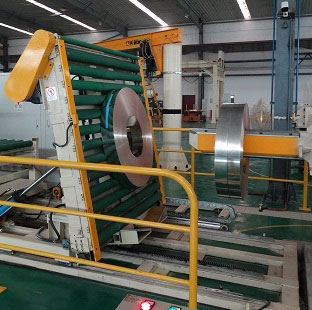
Modern designs accommodate coils from 15kg to 45 tons via adjustable arms, quick-change tooling, and programmable recipes—handling boutique alloys or mass-produced sheets without upgrades. PLC-controlled automation integrates smoothly within weeks, avoiding multi-month line shutdowns.
Proof emerges from Alabama’s Impact Forge that scaled wrappers twice as orders grew:
- Year 1: Single semi-auto unit processing 23 coils/day
- Year 3: Dual-robot cell handling 67 coils/day
- Year 5: AGV-fed automated warehouse packaging 220+ units
Code-based upgrades avoided $310,000 in "forklift rebuild" proposals.
Conclusion
A high-throughput packing line transforms coil handling from a cost center to a competitive accelerant. The physics-driven protection and metrics-proven ROI reveal undeniable math: each percent gain in high-speed packing efficiency compounds into market share growth. Stop battling preventable losses—engineer resilience into your core operations. The data confirms: those automating today dominate tomorrow.
